PRINCETON, NJ -- Republican John McCain and Democrat Barack Obama appeal to opposite ends of the age spectrum, with McCain faring better among older voters and Obama among younger voters. Hillary Clinton fares less well versus McCain than Obama does among younger voters, but she does better than Obama among older voters.
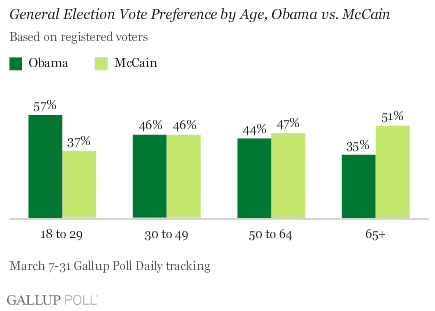
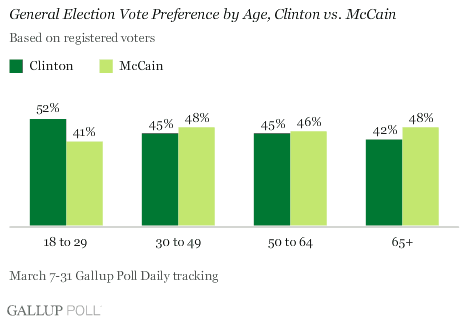
These analyses are based on aggregated data from �鶹��ýAV Poll Daily tracking conducted between March 7 and March 31. The results are based on interviews with more than 21,000 registered voters. Overall, both hypothetical general-election contests are close, with McCain holding a one percentage point advantage over both Obama and Clinton.
Obama's strength in a general-election matchup against McCain would be his appeal to young voters. Obama maintains a 20-point lead over McCain among 18- to 29-year-old registered voters, 57% to 37%, while McCain has nearly as large a lead among those 65 and older, 51% to 35%. The two are closely matched among the two middle age groups.
The general pattern of Democrat/Republican candidate support is the same in a Clinton-McCain contest, but Clinton's lead of 11 points over McCain among the youngest voters is only about half the lead Obama enjoys among this group. But she offsets her weaker performance among younger voters by doing better among older voters, trailing McCain by 6 points among senior citizens, compared to Obama's 16-point deficit versus McCain among older voters.
The analysis also affirms a significant gender gap in general-election voting preferences, as has been the case for the last several presidential elections. Female voters are once again aligning themselves with the Democratic candidate and male voters with the Republican. But here again, the sizes of the gender gaps differ, depending on whether Clinton or Obama is pitted against McCain. McCain has a 9-point advantage over Obama among male voters while Obama leads him by 5 points among women, for a total gender gap of 14 points. But if Clinton is the Democratic nominee, the gender gap expands to 22 points, with men going for McCain by 52% to 40% and women for Clinton by 51% to 41%.
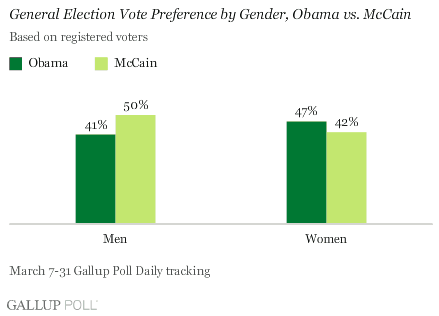
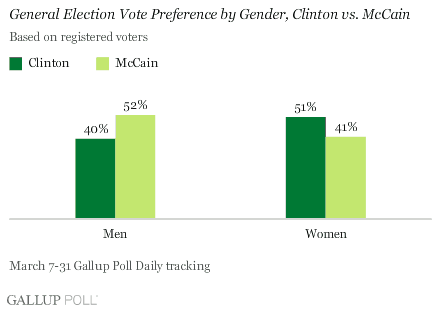
Looking at the interaction between age and gender, a Clinton-McCain contest would primarily divide Americans according to gender, with age having far less of an impact. McCain currently leads Clinton among younger (under age 50) and older (aged 50+) men, and by a similar margin in each case. Meanwhile, Clinton leads among both groups of women, but runs stronger among younger than among older women.
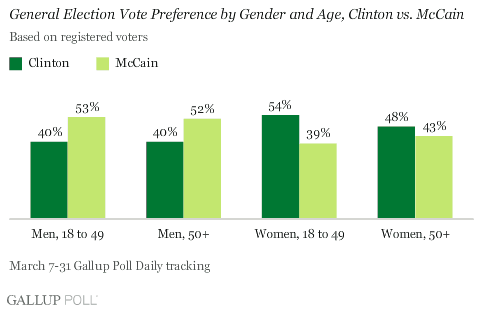
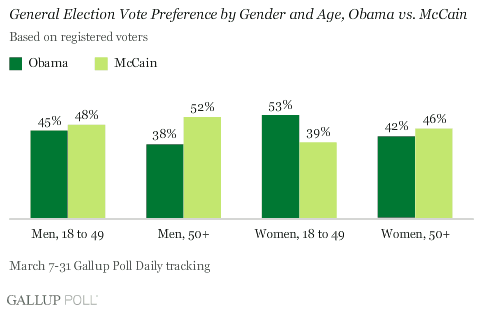
The age and gender relationships are a little less cut and dried with regard to Obama-McCain preferences, in part because the normal patterns of candidate support by gender and age can sometimes be at odds. Obama's strength among women and younger voters results in 18- to 49-year-old women breaking heavily in his direction in an Obama-McCain matchup, 53% to 39%. Conversely, McCain's relative strength with men and older voters results in men 50 years and older breaking heavily for him versus Obama: 52% to 38%. The other two gender/age groups -- older women and younger men -- represent conflicting political tendencies, and thus break about evenly for Obama and McCain, with McCain holding a slight edge in both cases.
Implications
�鶹��ýAV found similar differences by age and gender in . Given the usual relationships between age and gender and the vote in presidential elections, one would expect these patterns to persist throughout the election year. But the analysis does suggest there will be some key groups to track over the course of the election, including middle-aged voters (between 30 and 64), who currently equally divide between McCain and either Clinton or Obama.
Depending on who the Democratic candidate is, other groups may be important to deciding the outcome, including older women (in a McCain-Clinton contest) or younger men and older women (in an Obama-McCain election).
Survey Methods
Results are based on telephone interviews with 21,082 registered voters, aged 18 and older, conducted March 7-31, 2008. For results based on the total sample of national adults, one can say with 95% confidence that the maximum margin of sampling error is ±1 percentage point.
For results based on the sample of 10,341 male registered voters, the maximum margin of sampling error is ±1 percentage point.
For results based on the sample of 10,741 female registered voters, the maximum margin of sampling error is ±1 percentage point.
For results based on the sample of 1,545 registered voters age 18-29, the maximum margin of sampling error is ±3 percentage points.
For results based on the sample of 6,149 registered voters age 30-49, the maximum margin of sampling error is ±1 percentage point.
For results based on the sample of 7,086 registered voters age 50-64, the maximum margin of sampling error is ±1 percentage point.
For results based on the sample of 6,149 registered voters age 65 and older, the maximum margin of sampling error is ±1 percentage point.
Interviews are conducted with respondents on land-line telephones (for respondents with a land-line telephone) and cellular phones (for respondents who are cell-phone only).
In addition to sampling error, question wording and practical difficulties in conducting surveys can introduce error or bias into the findings of public opinion polls.
